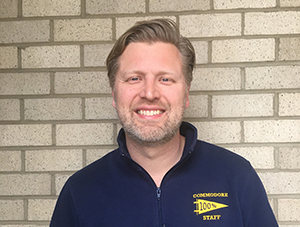April 2020 Featured Educator: Ryan Ariosa

For many English language teachers, the ones who didn’t always know they wanted to pursue a career in teaching, there seems to be a precise moment — or series of moments — that directly influences a complete change in course and decision to become an EL teacher.
For Ryan Ariosa that moment happened during his time as a special education teacher. Ariosa bonded with a student with special needs who grew up speaking Russian. The two developed a strong connection over their mutual love of reggae music.
“This student made such an impact on me. I was so curious about every aspect of his education experience,” Ariosa said. “Every Friday, someone I didn’t know worked with this student. At some point, he told me he was an English for Speakers of Other Languages (ESOL) teacher. As soon as I learned what that meant, I knew what I wanted to do, and I went back to school to get my master's degree in education.”
Fast forward to today. Ariosa teaches eighth grade EL students at Commodore John Rodgers Elementary/Middle School. He’s been teaching at Commodore for 10 years and has taught every grade from Pre-K to adults.
Commodore, a Baltimore City School, has nearly 900 students. Thirty-five percent are English Language Learners. Forty percent of all students are Latino (and many are former recipients of EL support services). As a Title I school, all students at Commodore receive free and reduced lunch.
This school year, Ariosa had a special opportunity to add to his duties at Commodore and join Teach for America as a content specialist. In his role, he mentors eight new ESOL teachers — teachers who did not receive any formal teaching training in college — in the Baltimore City School District.
“I didn't have a strong mentor when I started teaching,” Ariosa said. “So, I want to be one for these new teachers, to help ground their ship.”
Ariosa’s leadership responsibilities don’t end with his mentees. At Commodore, Ariosa serves as the school's lead ESOL teacher. There are nine ESOL teachers, one for each grade level.
“As the lead ESOL teacher, I host biweekly vertical meetings with the entire ESOL team. We collaborate, share ideas, and I share out district initiatives,” Ariosa said. “Commodore is an inclusive school, so ESOL teachers work with general educators in each subject area and students are assessed in class using the WIDA Standards and WIDA Can Dos.”
Ariosa stresses the importance of modifying units and lessons to meet each student’s individual English language proficiency needs.
“The WIDA tools are the baseline to what we use to properly gauge the progress our students are making within their English language proficiency,” Ariosa added.
“I found that backwards planning is the most effective method to use when developing scaffolds for ELs. Starting with the final assessment and creating modifications throughout each unit to ensure that English learners are learning the key concepts while reaching their language objectives for each lesson or unit.”
When he’s not thinking about lesson plans and in-classroom education, Ariosa likes to talk about an event that happens outside his classroom: multicultural night. It takes place once a year and Ariosa describes the night as an opportunity to watch “the cultures of our students come alive through shared cuisine and culturally unique performances.”
“It’s amazing to see the local community uniting on this night and celebrating our shared Baltimorean culture,” Ariosa said. “We have a very vibrant El Salvadorian and Honduran student and family population—and I have become enthralled with their culture and cuisine.”
It’s clear that Ariosa feels he made the right decision when he followed his "Aha!" moment into the English learner classroom. For him, it always goes back to the students, and their families, and the mutual impacts they have on each other’s lives — in and out of class.
“I love, love, love the students and their families, it is by far and away the best part of my job,” Ariosa said. “The relationships that I have made with our families leave me feeling like part of their extended family. I have parents and students reaching out to me to make sure my family and I are doing alright during this difficult time.”
Resources from the Commodore Team
Like their colleagues across the country, Ariosa and his team are trying to figure out how to best serve and support EL students in a virtual world. In an effort to make sure the education community has what it needs, the Commodore team put together a list of their go-to online resources.*
Distance learning teaching platforms
Through grants and fundraisers, we have been able to provide a computer or tablet to nearly every student in the building. Here are some of the online teaching platforms we use:
- Camtasia is a tool that allows a teacher to record what’s on their computer screen and make videos.
- Zoom is an online meeting software that teachers use to lead classes from home.
- Google Classroom is a useful tool that allows students to complete assignments on their own time, at home. Plus, students can directly communicate with their teachers when they need help.
Distance learning planning
When our team gets ready to plan, we share and interpret the WIDA ELD Standards. All team members should be involved, including the content area teachers and, if applicable, the special education teachers.
We use an educational tool called common curriculum. It helps us share, edit and make modifications to our lesson plans in real time. Three questions guide all of our planning:
- What entry points are in place to provide learning and engagement to everyone?
- What adaptations are needed for students with unique learning needs?
- How does their work during this lesson relate to larger goals?
Tools that help assess student learning
At Commodore, every grade level has an acceleration period that focuses on the reading levels of every student. Here are the tools we use (listed in order of use):
- Reading Horizons for all newcomer ELs, which starts with phonics and helps develop sight words to sentence level to paragraph level.
- Reading 180 helps ELs with their academic language progress — especially within the writing domain.
- Seesaw helps to track and gauge EL student’s oral language development.
Commodore resource
Commodore has a dedicated webpage that lists all of our go-to student resources. Many of these are great for at-home use.
*WIDA as an organization does not advocate for or endorse any of these technologies for instruction. Schools, districts and states are responsible for making choices about appropriate and applicable technologies and products.





